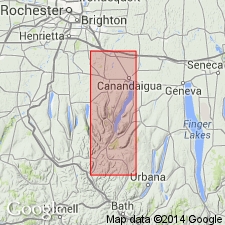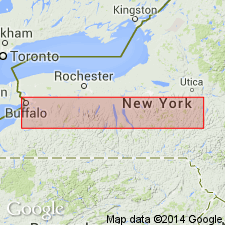
- Usage in publication:
-
- Cardiff shale
- Modifications:
-
- Named
- Dominant lithology:
-
- Shale
- Limestone
- AAPG geologic province:
-
- Appalachian basin
Summary:
Named for village of Cardiff, Onondaga Co., west-central NY. Named as top division of Marcellus beds or stage [broad sense]. Consists of dark, calcareous and black, slaty shales with thin layers of fossiliferous limestones, both of which weather to light ashen gray. Thickness is 50 to 100 ft. Overlies Stafford limestone; underlies Skaneateles shale of Hamilton. Age is Middle Devonian.
Source: GNU records (USGS DDS-6; Reston GNULEX).

- Usage in publication:
-
- Cardiff member
- Modifications:
-
- Revised
- Biostratigraphic dating
- AAPG geologic province:
-
- Appalachian basin
Summary:
Pg. 129-236. Cardiff member of Marcellus formation. In 1904 Clarke and Luther subdivided Marcellus into Marcellus and Cardiff in region east of eastern limit of typical Stafford limestone. But they fell into confusion because further west the shale below the Stafford is jet black and the shale above the Stafford is lithologically like the Cardiff. They therefore defined the Cardive as lying above the Stafford, when actually it lies on the Marcellus and is overlain by the Mottville, which is eastern equivalent of the Stafford. Since the Stafford is actually = basal bed of the Skaneateles it is necessary to exclude it from the Marcellus. The Marcellus of eastern New York is here divided into (descending): Cardiff member (light-colored); Chittenango member (black); Cherry Valley limestone member (black); and Union Springs member (black). In Cayuga and Seneca Lakes region the Marcellus is divided into (descending): Oatka Creek member; Cherry Valley member; and Union Springs member; the Oatka Creek member (black shale, 30 to 50 feet thick) being correlated with Chittenango (black) and Cardiff (gray shale and sandstone) members. Farther west the Union Springs (black) and Cherry Valley (black) members thin out and the black Oatka Creek is sole representative of Marcellus. A striking change in facies is seen as Cardiff beds are traced east and west from their type section. In Chenango Valley and eastward the Cardiff shale is represented by three members, a sandy Solsville member separating an upper [Pecksport] and lower [Bridgewater] gray shale member. West of Chenango Valley the sandy member disappears and entire sequence is one of nearly homogeneous dark gray shale. Still farther west it becomes black shale and forms part of Oatka Creek shale. The eastward change in facies in Chenango and Unadilla Valleys is attended by marked change in faunal facies. The dark shales of the Cardiff are characterized by a "LEIORYNCHUS fauna," but as those become sandier in eastern part of State, true Hamilton forms replace those of the Cardiff, and in upper part of Marcellus formation (Pecksport and Solsville members) in Unadilla Valley, Hamilton species predominate. In vicinity of Schoharie and Catskill the jet-black Marcellus is succeeded directly by strata having a Hamilton fauna, the Mount Marion beds, suggesting that the replacement of the "LEIORHYNCHUS or Marcellus facies" by that of the Hamilton is complete in eastern part of the State. [Age is Late Devonian.]
Source: US geologic names lexicon (USGS Bull. 896, p. 346-347).
For more information, please contact Nancy Stamm, Geologic Names Committee Secretary.
Asterisk (*) indicates published by U.S. Geological Survey authors.
"No current usage" (†) implies that a name has been abandoned or has fallen into disuse. Former usage and, if known, replacement name given in parentheses ( ).
Slash (/) indicates name conflicts with nomenclatural guidelines (CSN, 1933; ACSN, 1961, 1970; NACSN, 1983, 2005, 2021). May be explained within brackets ([ ]).

